Content
- 1 Classification of potato varieties
- 2 Overview of potato varieties
- 3 Potato varieties for different regions of the country
- 4 Potato varieties by purpose
- 5 Reviews of potato varieties
- 6 Growing potatoes in the Middle Lane
- 7 Early varieties of potatoes for Central Russia - description
- 8 Mid-season and high-yielding
- 9 Late ripening
- 10 High-yielding varieties
- 11 The most delicious potatoes
- 12 Elite tubers
- 13 New to the Middle Lane
- 14 Potato varieties for the Urals
- 15 Middle Volga region
- 16 List of the best potato varieties alphabetically
- 17 Potato subspecies
- 18 1. Adretta
- 19 2. Gala
- 20 3. Zhukovsky early
- 21 4. Red Scarlett
- 22 5. Rosara
- 23 6. Sante
- 24 7. Pace
Breeders have bred more than 280 varieties of potatoes, which are recommended to be grown in personal plots. The best varieties of potatoes are characterized by good yield, excellent taste and presentation, immunity to bacteria and viruses.
Classification of potato varieties
Ripening classification:
- ultra early - up to 1.5 months;
- early - up to 2 months;
- medium - up to 3 months;
- late - from 3 months to 140 days.
Potato varieties are bred for different purposes:
- fodder - used as fodder for livestock; potatoes are large, contain a lot of protein and starch;
- universal - allowed for use in cooking and for feeding livestock; with a starch value of 16-18%;
- technical - dry matter more than 16%, are used as raw materials for the production of starch and alcohol;
- canteens are of the greatest interest for gardeners, as they are used in cooking.
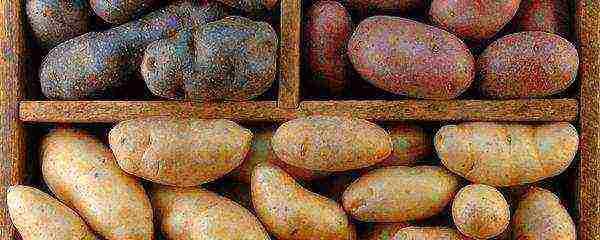
Table varieties contain a different percentage of dry matter - starch and are divided into types:
- Type A - low dry matter value up to 14%; the tubers are dense, do not boil over, they are used for side dishes and salads.
- Type B - 14-17% starch; this type includes varieties that are used for frying and making chips.
- Type C - from 17 to 20% dry matter; average cookability.
- Type D - starch value up to 25%. This type includes varieties of fully boiled potatoes, which are used to obtain dry mashed potatoes.
Characteristics of the color of the peel:
- red peel - shelf-stable potatoes, contains a lot of antioxidants;
- white and yellow potatoes — taste good and have more starch than red tubers.
Overview of potato varieties
Below we take a look at the most popular potato varieties for various characteristics.
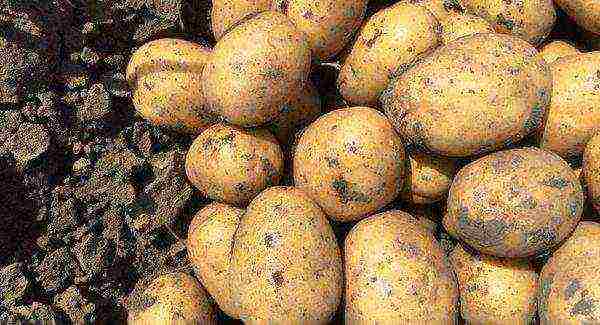
Super early varieties
The growth period is 45-60 days. Their advantages are minimal watering 2-3 times, resistance to late blight and the ability to harvest twice a season.
The main disadvantage of early potato varieties is that the tubers are not suitable for storage, as their skin is very thin. The harvest quickly becomes sluggish and loses its flavor.
- Impala is a Dutch selection. Resistant to damage during harvesting. Tubers are slightly oval, ripen in 50 days. The surface is yellow, has no roughness, the average starch is up to 15%, the weight of the potato is 160 g.
- Bellarosa - bred in Germany. The shape of the potato is spherical, weight - 200 g, the flesh on the cut is beige, the skin is rough, pinkish. Immune to bacteria.
- Alyona. A variety of oblong potatoes. The tuber weighs 130 g, the peel is pinkish. The pulp is light beige, does not darken during cooking; dry matter content 15%.
- Riviera. Dutch variety. Potato - rounded, weight - 140 g. Peel - yellowish, flesh - beige, starch up to 16%.
- Timo. Finnish potatoes. The growth period is 45 days. Potatoes weighing up to 120 g, round. Smooth surface of the tuber, brown-yellow color; starch - up to 14%, the pulp is pale, almost white.
Medium varieties
With a ripening period of up to 100 days. They are grown for storage for the winter, as the tubers are mature and do not germinate until spring.
- Gala. A spherical vegetable with light flesh and brownish peel. Tuber weight - 120 g. It has average starch values.
- Red Scarlett. Dutch selection. The tubers are oblong with a flat surface. The skin is reddish, the flesh is almost white. Weight - up to 120 g.
- Rosara. A variety of German selection. Tubers grow up to 70 days. The shape of the potato is oblong, weighing 150 g, with beige pulp and pinkish skin.
- Karatop. The tubers mature for 70 days. Little eyes. The potatoes are elongated, the peel is brownish, the flesh is pale yellow.
- Sante is a Dutch selection. Vegetable weighing 80 g, with a golden skin, cream tuber on the cut.
Late varieties
The growth period is from 90-140 days. They contain the maximum amount of carbohydrates and nutrients. They are stored for a long time until the next harvest without germination. Tubers are less likely to suffer from diseases.
- Picasso is a Dutch breeding potato. There is little starch in the composition, it does not boil over. A vegetable weighing 120 g, creamy on the cut, the skin is yellow with burgundy specks.
- Pace. Potatoes weighing 150 g, contains 22% starch; on the cut - beige.
- Nevsky. The tuber is round, 120–130 g, pale cream on the cut. The surface is without roughness, pale yellow, the eyes are pinkish, shallow.
- Nikulinsky. The vegetable weighs 90 g, elongated, the skin is light beige with pinkish spots, on the cut of the potato it is snow-white.
- Zhuravinka is a Belarusian selection. Oval tubers of pinkish tint, up to 160 g. Does not suffer from drought.
The most productive varieties

They give over 350 centners per hectare, and with the addition of additional fertilizing and proper watering - up to 800 centners per hectare.
- Temp - tubers are large, with a yield of 550 c / ha.
- Good luck - with an average starch index, it is capable of producing a yield of 960 c / ha.
- Zhukovsky. Vegetable weighing 165 g, with a yield of up to 500 c / ha. The skin of the tuber is pink, the flesh is pale yellow.
- Bellarosa. A very early variety, which, with proper care, gives a yield of 400 c / ha of young potatoes.
- Idaho. Early potatoes with starch up to 17%. The tuber rind is smooth. Productivity - up to 600 kg / ha.
The most delicious varieties
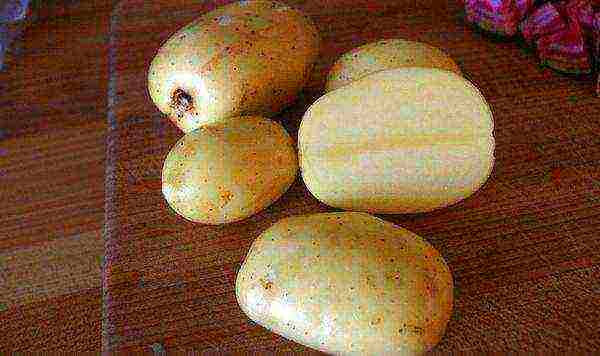 Mona lisa
Mona lisa
They contain a lot of amino acids, starch, bioflavonoids and fiber.
- Mona Lisa is a mid-early variety. Potato weight - 80 g; the skin is hard.
- Bentier is a medium early potato. The skin is brown, the cut is a beige pulp, weight is 120 g, there are few eyes.
- Symphony is a medium-ripening variety. The color of the potato is red, the flesh is yellowish, weight 120 g.
- Adretta. Spherical potatoes. The rind and flesh are beige; the surface of the tuber is rough.
- Simpley Ed. Reddish tuber, flesh - beige, contains many antioxidants.
For clay and sandy soils
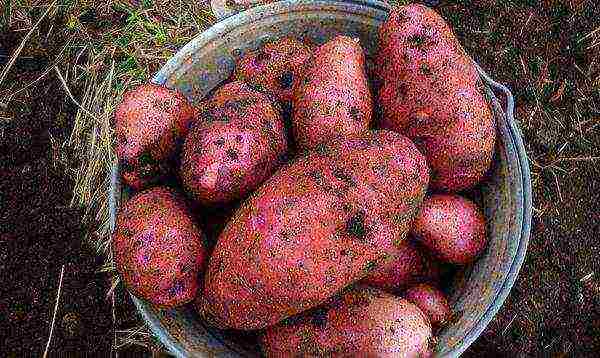 Rodrigo
Rodrigo
Potato varieties are selected that are capable of bearing fruit on heavy, dense soils. In clay areas, water stagnates after heavy rains, and a crust forms when it dries.
Sandy soils have low porosity, quickly pass air and water, and are not able to retain moisture. For such plots of land, you need to choose drought-resistant varieties.
- Gatchinsky. Potato shape - spherical, weight - up to 140 g; the pulp is creamy. Productivity - up to 450 kg / ha.
- The glow is a mid-late potato. The skin is pinkish, the tuber on the cut is white, the dry matter content is 22%. Productivity - up to 400c / ha. It has wide leaves that do not allow moisture under the bush to evaporate quickly.
- Bellarosa - on heavy soils forms up to 10 tubers weighing 150-200 g on a bush. The root system penetrates deep into the ground, where it extracts water and nutrients.
- Cleopatra is a Dutch variety. The skin is red, the flesh is pale yellow, starch is 13%; tubers are large.
- Rodrigo is a German-bred potato. Large tubers up to 200 g, the skin is reddish, the flesh is beige.
Universal varieties capable of bearing fruit on different soils - "Zhukovsky", "Nevsky".
Potato varieties for different regions of the country
The climate of different regions of the country is different. Therefore, for each zone, potatoes are selected that can bear fruit well in certain weather conditions.
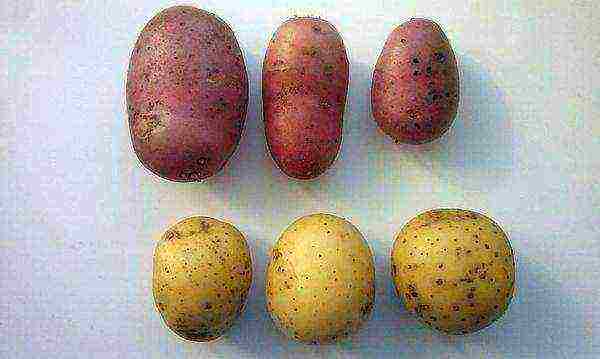 Rodrigo and Gala
Rodrigo and Gala
For Moscow region
The climate is moderately continental with relatively mild winters and rainy summers. The first frosts are possible from mid-September.
It is recommended to plant the best early varieties: Impala, Nevsky, Zhukovsky, Vesna, Luck, Bellarosa, Sineglazka, Bryansky Early.
For Siberia
An area with a sharply continental climate, with late spring frosts, short summers and heavy rains at the end of the summer.
Under such conditions, early and middle varieties are grown: "Tuleevsky", "Nevsky", "Adretta", "Impala", "Luck", "Lyubava".
For the Urals
A short warm period is characteristic, especially in the north and in the central part of the region. Choose early and medium varieties for cultivation: "Luck", "Timo", "Riviera", "Impala", "Gala", "Nevsky".
Middle zone of Russia
It is characterized by a temperate climate with high humidity. Warm seasons are from late May to mid-September. The best potato varieties for the middle lane:
- early - "Bellarosa", "Impala";
- middle - "Rosara", "Sante", "Slavyanka";
- later - "Picasso", "Nevsky", "Zhuravinka".
For southern areas
Hot summers and lack of moisture are typical. The very early varieties "Udacha", "Impala", "Alena", "Zhukovsky" give a harvest before the onset of heat. They are grown twice a season.
With sufficient watering, late varieties are grown: "Nevsky", "Temp", "Picasso", "Nikulinsky".
Potato varieties by purpose
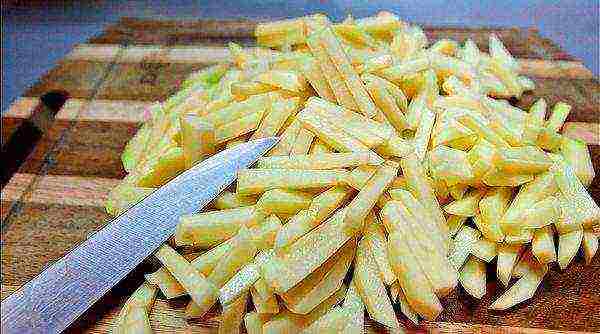
For frying
Suitable potatoes with a low starch content of 14-17%: "Impala", "Alena", "Sante", "Luck", "Ryabinushka".
For mashed potatoes
They choose potatoes with starch from 17 to 25%: "Gala", "Fairy Tale", "Nevsky", "Zarevo", "Verba", "Atlant", "Adretta".
For long-term storage
An early ripe crop can be stored until mid-autumn, then the tubers germinate and wither.
It is better to use medium and late potatoes for storage. It has a thick skin, is resistant to fungal diseases, does not rot during storage. Stored without significant weight loss "Nevsky", "Sante", "Minerva", "Slavyanka", "Gatchinsky" "Adretta".
Reviews of potato varieties
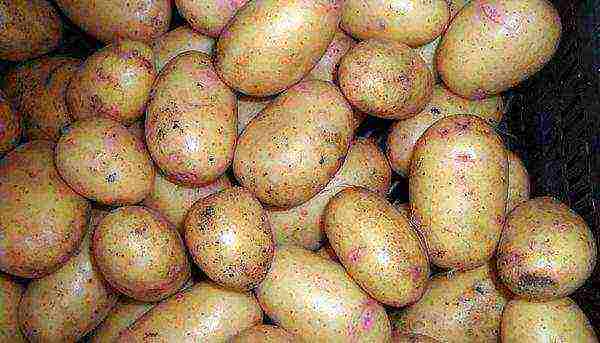
"Nevsky" is positively assessed by vegetable growers. This is a delicious potato with a yield of up to 15 tubers per bush. It is also immune to bacteria. Tubers are oblong, easy to clean without roughness. Potatoes "Nevsky" are heat-resistant. Therefore, it is cultivated in their gardens by amateur summer residents. It is also popular for commercial cultivation.
Bellarosa is an early table potato. Mass harvest is recommended 55 days after planting. You can selectively dig in the bushes already on the 40th day.For the opportunity to get young tubers so early, the variety is appreciated by summer residents. In addition, in areas with a mild climate, the variety is grown twice a season.
The advantage of Bellarosa is the ability to produce crops on heavy soils and on dry areas without an automatic irrigation system.
Temp potatoes are popular among gardeners. It has large tubers with a high starch content of up to 23%. It is used for industrial purposes, for making starch and dry purees. It is appreciated by private growers for its good taste and quick digestibility.
Choosing the best potato variety starts with studying the climate and soil composition of the region. With this approach, early potatoes will delight in harvest in early summer, and late potatoes are used during winter. The ability to navigate the varieties will help you choose the right vegetable for frying and various dishes: soups, side dishes, mashed potatoes.
What kind of potatoes to plant in Central Russia. It depends on what you want to get in the end: early potatoes or for the winter, tasty or beautiful. Formulate a preference, analyze the existing conditions: soil and climate, and the choice will be obvious.
Growing potatoes in the Middle Lane
A characteristic feature of the Middle zone, in other words, the Central European part of Russia, is a temperate continental climate and excessive humidity. There are no severe frosts and heat here. Moderate seasonality: snowy and mild winters and warm and cool summers. Average temperatures in winter are kept within -8, -12 degrees, in summer +17, +23. The warm period lasts from late May to mid-September.
Gardeners in this region have to throw all their strength into combating excess moisture, which turns their peat and podzolic soils into swamps. The potato yield is quite high here - up to 0.5 tons. With special care, these indicators increase by 10-20%.
Potato types
According to the ripening rate, potatoes are divided into the following types:
- Early - ripen in 50-60 days from the moment of germination, are not subject to storage, are eaten immediately after digging up.
- Mid-ripening - 70-90 days from germination - are distinguished by good growth and storage in the conditions of Central Russia.
- Late ones - more than 100 days - are not grown in the open field of this region, as they do not have time to ripen.
Planting potatoes in the Middle Lane begins in early May, when the soil warms up to +12 degrees, and the night air is not lower than +15 degrees. At first, planting is covered with a film from sudden frosts.
Potatoes are usually watered with precipitation. The exception is the emergence of sprouts, budding and the end of flowering. During these periods, plants need additional watering and feeding.
Not every potato variety can be grown in Central Russia.
Climate-dependent variety
A good harvest will give a variety that matches the type of soil and climatic characteristics of the region. The middle lane is a huge territory, in different areas of which there are distinctive weather conditions. Therefore, preferences are given there to different varieties of potatoes.
For example, in the Moscow region, with its high humidity and cloudiness, they choose for planting mainly early varieties of potatoes with good resistance to late blight. The most common are Early rose, Falensky, Provento, Lyubimets, Ostara, Lorkh, Peredovik, Early Priekulsky, Penza early ripening, Lugovskoy, Nevsky, Charodey, Sineglazka, Luck, Zhukovsky.
In the north-west of Russia, the advantage is in varieties that tolerate frosts and sudden temperature changes well. Amorosa, Impala, Latona, Karatop, Nida, Garnet, Romano, Aurora, Folva are popular.
Early varieties of potatoes for Central Russia - description
To get a harvest in the middle of summer, gardeners grow unpretentious early potatoes, which ripen before the spread of diseases and all kinds of pests begins. You can dig up fresh potatoes in the open field after 50 days from the moment of germination, and even earlier in greenhouses and greenhouses.But having dug it out, it must be eaten immediately, since it cannot be stored for a long time.
Most popular early varieties table
Most popular varieties - photo gallery
Mid-season and high-yielding
The most popular potato varieties are mid-season. They keep well in winter and their tubers taste much better than early ones.
Popular mid-season varieties table
Photo gallery
Late ripening
Late-ripening potatoes in Central Russia do not have time to ripen, therefore they are not grown here in the open field.
The best late potato varieties table
The best late varieties - photo gallery
High-yielding varieties
Every gardener wants to have high-yielding potatoes on his plot. Many varieties with good performance are intended for Central Russia. But in order to achieve them, you need to provide plants with good care, including weeding, watering, hilling, fertilizing, protection from diseases and pests.
The highest-yielding varieties - table
High-yielding varieties photo
The most delicious potatoes
The taste of tubers is the main reason for which potatoes, in principle, are grown by gardeners. In this matter, you should take into account your culinary preferences. Some varieties of potatoes are good for mashed potatoes, others are great for soups and baking, others can be eaten raw, added to a salad, there are also varieties of universal preparation.
The most delicious varieties - table
The most delicious root vegetables - photo
Elite tubers
The potatoes obtained from the elite sowing material are not subject to diseases and pests, have excellent taste and high yield. The cost of the elite is higher than that of other varieties, so not every gardener can purchase it.
Elite varieties include:
- Dutch selection - Red Scarlet, Latona, Romano, Impala, Condor - yield 600-800 kg per one hundred square meters. It is possible to grow on the site for no more than 3 years, then the planting material should be updated.
- Russian selection - Luck, Golubizna, Lugovskoy, Zhukovsky early, Nevsky - the yield is much lower than the Dutch ones, but they do not degenerate longer. They can be grown on the site for more than 5 years, propagating with tubers from the best bushes.
Elite potato varieties - table
Elite varieties of potatoes photo
New to the Middle Lane
Breeders continue to work for the good of society, creating more and more varieties of potatoes. Many of them are suitable for growing in the Middle Lane.
New tastes and types - table
New varieties of potatoes photo
Potato varieties for the Urals
In the Urals, the climate is rather harsh for plants: constant temperature drops, dramatically changing weather conditions, uneven distribution of precipitation. For cultivation in this region, you need to choose only resistant and zoned varieties.
The best potato varieties for the Urals table
The best potato varieties for the Urals photo
Middle Volga region
A characteristic feature of the Volga region is instability and weather anomalies associated with the influence of Asia and the Atlantic. Here, the cold summer quickly turns into hot summer, the spring is short, especially in the southern regions, the frost-free period sometimes lasts up to 150 days. The lack of moisture in the soil and air due to the low amount of precipitation, frequent prolonged droughts cannot positively affect the agricultural activity of the region. Winds, dry winds and dust storms add complexity. It is necessary to choose a potato variety for growing in the Volga region with good drought tolerance.
Potato varieties for the Middle Volga region table
Potato varieties for the Volga region photo
Growing and harvesting potatoes is possible in every region. The main thing is to choose the right variety.
Rate the article:
(9 votes, average: 3.8 out of 5)
Potatoes have long been considered the most popular crop grown in Russia.Consider in the article which varieties are best to choose in order to get a high-quality and large harvest.
List of the best potato varieties alphabetically
There is approximately 280 subspecies potatoes that can be grown in different climatic zones. Many varieties have found their popularity in industrial production, some have fallen in love with summer residents to plant on the site. Let's consider the most popular varieties and species in a small alphabetical catalog.
Idaho
Its main advantage is a large, even fruit.
Main characteristics:
- early ripening variety;
- productive - 500 c / ha;
- most popular for cooking in restaurants;
- high resistance to diseases;
- contains a high level of starch up to 17%.
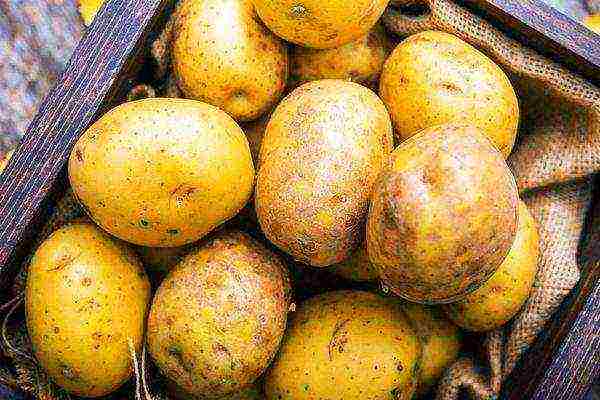 Idaho is the most popular variety for cooking in restaurants
Idaho is the most popular variety for cooking in restaurants
Planting is carried out in early spring, when the frost has already passed, and the temperature reaches 8 degrees.
Bela Rosa
Bela Rosa is the most popular in the territories of the CIS countries.
Main characteristics:
- early maturing, in the south you can get several harvests per season;
- with proper watering and feeding, high yield - 350 c / ha;
- large oval-shaped root vegetable (about 200-500gr fruit).
You should know that it grows poorly on the ground without feeding. It is recommended to grow it after legumes.
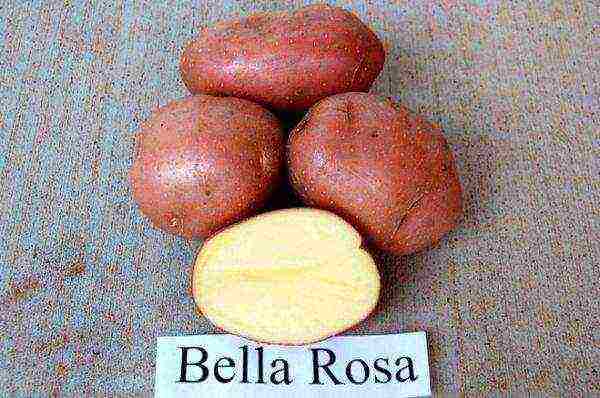 Bela Rosa
Bela Rosa
Red Scarlet
The Dutch variety is not inferior in its characteristics even to the Belarusian ones. It is characterized by medium roots with excellent taste characteristics.
Often used for cooking in restaurants.
Main characteristics:
- the bush is undersized, blooms with lilac flowers;
- the variety is susceptible to diseases: phytosphorosis and scab;
- the fruit resembles an oblong oval in shape;
- the peel is red to pinkish purple;
- cream-colored pulp;
- tolerates heat well;
- the weight of one fetus is from 70-200 grams;
- on one bush up to 15 tubers.
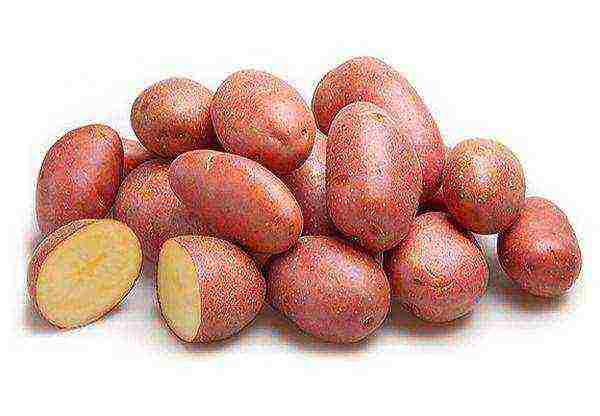 Red Scarlett
Red Scarlett
Rosara
Rosara belongs to the early maturing, ripens within 70 days... Used in new and modern industries for the preparation of dry raw materials.
Main characteristics:
- the pulp has a pale yellow tint;
- on average, the fetus weighs about 70-130g;
- the shape of the fruit is oval, slightly elongated;
- keeps its shape well due to the low starch content;
- yield 500 c / ha.
 Rosara
Rosara
Picasso
Refers to late varieties of potatoes. Fully matures later 110-130 days after germination.
Main characteristics:
- high yield, from 1 hectare it can turn out up to 20 tons potatoes;
- the color of the tubers is pink-yellow;
- the weight of one fruit fluctuates from 100-150 gr;
- the pulp is white-yellow;
- the taste is amazing;
- susceptible to disease - late blight;
- has a long shelf life.
Planting the plant is carried out in the spring, when there is no longer frost, but the soil is still moist.
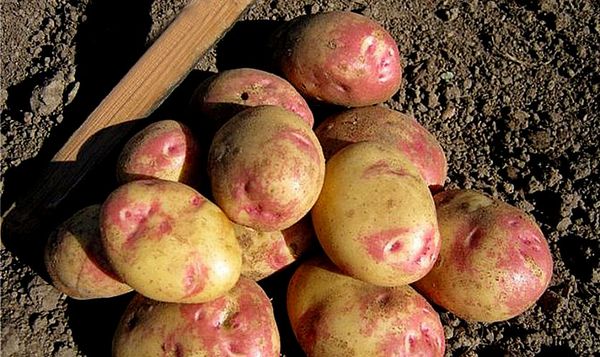 Picasso
Picasso
Tuleyevsky
Tuleyevsky is well adapted to many climatic conditions, is actively planted on farms.
Main characteristics:
- the shape of the fruit is even, oval;
- the pulp is light yellow;
- fetal weight 100-300 gr.;
- during cooking it retains its shape well;
- has an excellent potato flavor;
- does not require constant fertilizing with fertilizers.
Planting begins only after the soil warms up to +10 degrees. Does not require watering. Minus is his cannot be stored for a long timeas it starts to wither.
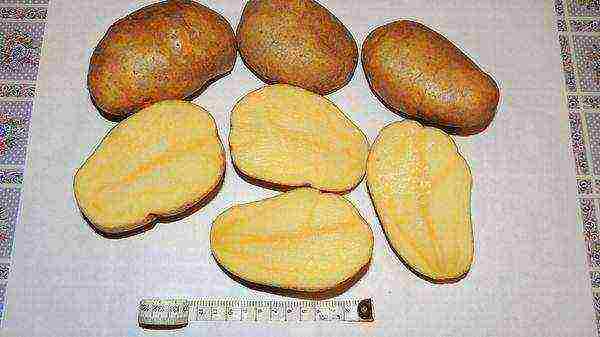 Tuleyevsky
Tuleyevsky
Gala
The German early-ripening potato variety Gala has excellent taste and is distinguished by the content of a large amount of starch in the fruit.
Main characteristics:
- from 1 weave you can collect up to 400 kg potatoes;
- root crops are round, small in size with a yellow skin;
- the pulp is bright yellow;
- average weight of potatoes 60-130gr;
- prone to black parasha infestation.
It is considered one of the best hybrid varieties.
Ripens within 75 days, during this period potatoes can be harvested. You need to plant potatoes as soon as the air temperature reaches 10 degrees.
Dauphine
Delicious Dutch, considered one of the most delicious root crops of potatoes.
Main characteristics:
- from 1 are collected up to 220 kg harvest;
- tuber weight varies from 150 to 350 g;
- about 20 fruits come out from one bush.
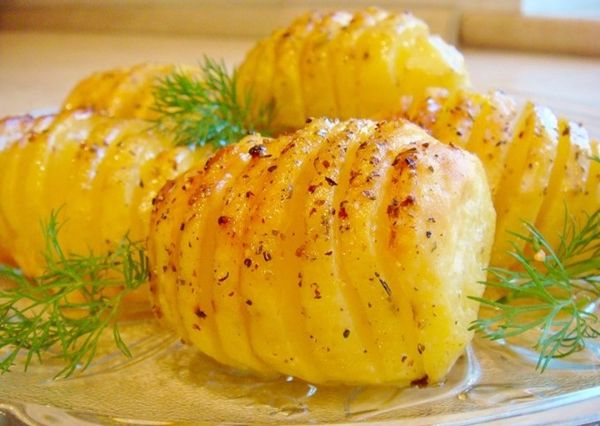 Dauphine is one of the most delicious potatoes
Dauphine is one of the most delicious potatoes
Share
The most suitable variety for those who want to grow potatoes for themselves.
Main characteristics:
- has excellent taste;
- gives a high yield up to 390 kg per hectare;
- tuber weight reaches 400 g;
- bushes of the variety are high, strong up to 80 cm;
- well boiled during cooking;
- resistant to diseases such as powdery mildew and fungi.
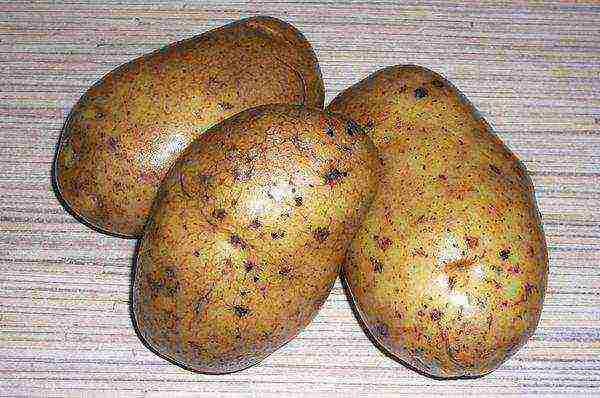 Share
Share
Nevsky
There are several varieties of Nevsky in terms of ripening time. It is considered elite, grows well in any conditions.
Main characteristics:
- yield up to 350 kg from a hundred;
- for planting, you need to choose not sprouted tubers, after germination, plant those with short sprouts;
- tubers with long sprouts are unacceptable for sowing;
- refers to mid-late;
- ripening occurs in 75-90 days;
- oval in shape, with a light yellow skin and creamy flesh;
- they love warmth, so it is recommended to plant when the frost has passed.
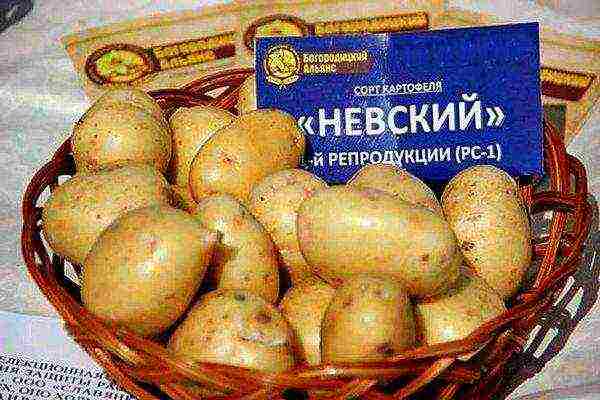 Nevsky
Nevsky
Latona
It is considered an early maturing dining room.
On the 45th day, you can already get the first harvest, but in general, the harvest time is 70-75 day.
Main characteristics:
- from each bush you can collect 2 kg fruits;
- resistant to weather conditions, tolerates transportation well;
- practically immune to diseases, there is a possibility of infection with late blight and viral diseases;
- the pulp is pale yellow;
- requires care, watering, organic matter;
- keeps well during the winter.
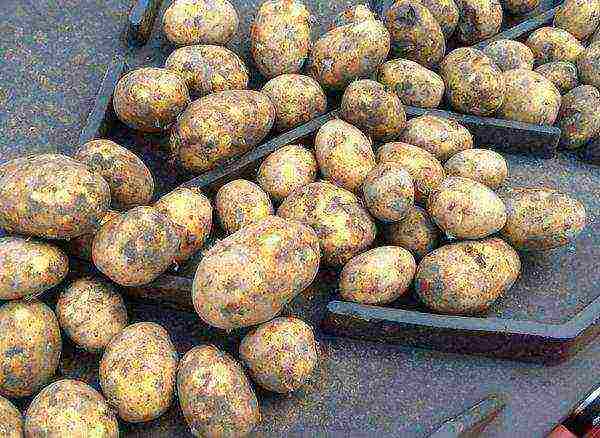 Latona
Latona
Luck
Refers to the elite who require special care... If you follow all the rules, you can collect up to 950 c / ha.
Main characteristics:
- tuber weight 170 g;
- refers to the mid-season (on average 90 days);
- up to 15 kg of root crops can be collected from a bush;
- perfectly tolerates winter and keeps well for a long time.
Adretta
Bred by breeders in Germany 25 years ago. We are still loved by gourmets due to its excellent taste.
Main characteristics:
- the peel has a yellow tint, slightly rough to the touch;
- the pulp can be light yellow or deep yellow;
- the shape of the root crop is round-oval;
- average fetal weight 140 gr.;
- the variety can be planted in open ground at the end of April, propagated by tubers;
- full maturation occurs in 65-80 days;
- high-yielding, from 1 hectare you can get up to 45 tons.
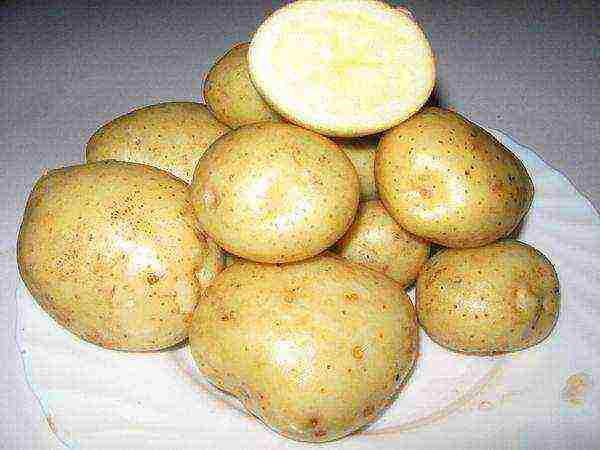 Adretta
Adretta
Felox
It belongs to the early maturing, perfectly tolerates heat and sudden changes in temperature.
This subspecies can be found in all regions of Russia.
Main characteristics:
- root vegetable weight varies from 80 to 200 gr;
- the peel has a delicate amber hue;
- the pulp is light yellow;
- before planting, it is recommended to process it with copper sulfate;
- contains a high level of starch up to 17%;
- harvested from one hectare 250 centners potatoes;
- planting is carried out in early May.
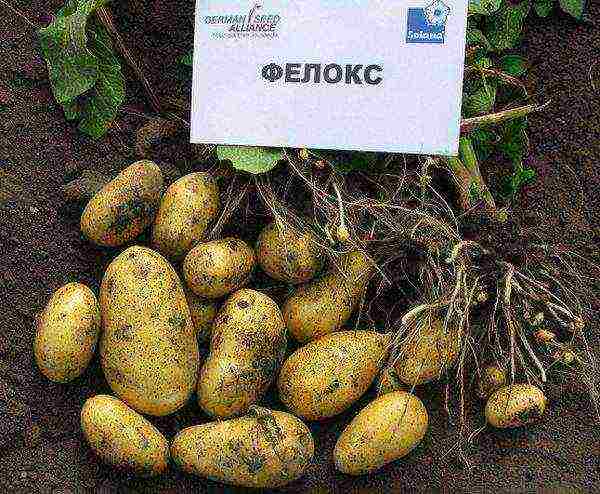 Felox
Felox
Sprint
Early ripe potatoes have a pleasant taste.
Main characteristics:
- an elongated oval fruit;
- the peel is yellow, the pulp is light cream;
- tuber weighs about 80-200 gr;
- contains a high level of starch up to 17%;
- there is a possibility of infection with late blight;
- yield 300 c / ha.
The palatability of potatoes is improved if they contain a large amount of starch. You can influence the taste of the fruit with the right care: watering, fertilizing.
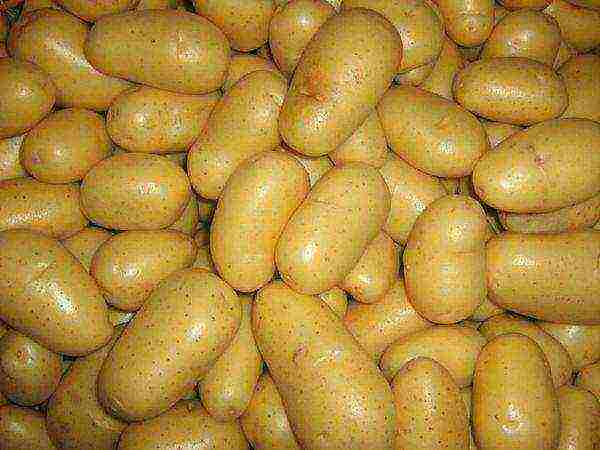 Sprint
Sprint
Potato subspecies
Different varieties of potatoes are suitable not for all regions of Russia... Although most are acclimatized to the temperate zone, there are varieties that are most suitable for central Russia and Siberia.
Also, potatoes differ in the shade of pulp, taste, ripening time. Based on this, they can be classified as follows:
Classification of varieties by growth
| Geographical position | Variety names |
| For central Russia | Nevsky, Felox, Sprint, Latona, Red Scarlet, Picasso |
| For Moscow region | Tuleyevsky, Gala, Nevsky, Luck, Sprint, Pai, Dauphine, Idaho, Bela Rosa, Rosara |
| For Siberia | Adretta, Luck, Scarlet, Tuleyevsky, Nevsky |
Types by yield
| Red potatoes with yellow flesh | Bela Rosa, Red Scarlet, Rosara |
| Loose varieties | Idaho, Pye |
| High yielding | Rosara, Adretta, Luck |
| Pink potato | Picasso |
| Potato yellow | Idaho, Tuleyevsky, Gala, Sprint, Felox |
Ripening classification
| Medium early | 50-60 days | Idaho, Bela Rosa, Rosara, Red Scarlet |
| Mid-season | 80-95 days | Latona, Luck |
| Mid late | 95-100 days | Atlant, Nevsky |
| Late | 4 months | Picasso |
All of the above potato varieties have excellent characteristics and taste. Most are disease resistant and yield high.
To get an excellent potato crop that will delight you with excellent taste and will be well stored, plant one of these varieties on the site.
Have you ever wondered why one potato turns out surprisingly tender and airy puree, but during heat treatment it loses its taste and color, and another variety "behaves" exactly the opposite? Not to mention, different varieties show different yields, ripening times and disease resistance. Based on all these factors, it is worth choosing potato varieties for your garden.
So that the harvest does not disappoint you, we recommend choosing one of these time-tested varieties that boast excellent taste, high yields and good keeping quality.
1. Adretta
An early variety that is highly resistant to diseases and unfavorable weather conditions. Adretta is not afraid of frost, so you can safely plant her on your site.
The tubers are covered with a dark yellow rind, under which is the flesh of the same color. The taste of potatoes is wonderful, they do not lose their quality after long-term storage.
| Appointment | Productivity (kg / 100 sq.m) | Tuber weight (g) | Maturation (days) | Pulp color |
| 200-450 | 100-150 | 60-80 | Dark yellow | |
2. Gala
The indisputable advantage of this German variety is its low starch content and high carotene content, which makes this potato suitable for dietary nutrition. Gala, as they say, combines business with pleasure: excellent taste and high resistance to diseases and pests (scab, potato crayfish, nematode). Importantly, this potato variety gives a good harvest and is well stored.
The flesh and skin of the tubers are yellow. Average weight is about 100 g.
Gala is great for making boiled potatoes and mashed potatoes.
| Appointment | Productivity (kg / 100 sq.m) | Tuber weight (g) | Maturation (days) | Pulp color |
| 340-550 | 100-110 | 60-80 | Dark yellow | |
3. Zhukovsky early
This variety can be considered ultra-early: the tubers are ready for consumption already 55-60 days after planting. Moreover, they are quite large - the record holders can weigh up to 170 g. Zhukovsky's pulp is early white and, most importantly, does not darken when cutting.
The tubers are not afraid of mechanical damage and are perfectly stored. The variety is resistant to late blight, scab and other diseases.
| Appointment | Productivity (kg / 100 sq.m) | Tuber weight (g) | Maturation (days) | Pulp color |
| 200-450 | 100-170 | 55-60 | White | |
4. Red Scarlett
This Dutch table potato variety can be considered a true yield champion in the middle lane. As you might guess from the name of the variety, the skin of the tubers is red. The eyes are shallow. Red Scarlett potatoes taste good, and their flesh retains a pale yellow hue even after frying. In addition, the tubers are quite large - the weight of one can reach 120 g.
In addition to all its obvious advantages, this variety is quite disease resistant.
| Appointment | Productivity (kg / 100 sq.m) | Tuber weight (g) | Maturation (days) | Pulp color |
|
450-600 |
60-120 | 70-90 | Pale yellow | |
5. Rosara
If you want to pamper yourself with delicious young potatoes at the beginning of summer, plant Rosaru on the site. One bush grows up to 15-25 tubers. All of them are as if they were a selection: the same size and neat oval shape. Moreover, the weight of one tuber can reach 150 g. This early variety has excellent taste: it is ideal for cooking French fries and chips.
What is pleasant, Rosara shows not only high, but also stable yield: potatoes do not reduce "indicators" for 4-5 years.
| Appointment | Productivity (kg / 100 sq.m) | Tuber weight (g) | Maturation (days) | Pulp color |
| 300-500 | 85-150 | 65-70 | Yellow | |
6. Sante
Sante is a medium early Dutch potato variety. Its strong point is its high resistance to late blight and other diseases. We can say that Sante practically does not get sick. In favorable years, this variety can be grown without the use of chemicals.
The tubers have a golden skin and light yellow flesh. Their average weight is about 80 g. Potatoes boast good keeping quality. And also it has a pleasant taste and is great for frying, making chips.
| Appointment | Productivity (kg / 100 sq.m) | Tuber weight (g) | Maturation (days) | Pulp color |
| 300-600 | 70-90 | 80-90 | Light yellow | |
7. Pace
This is a very productive late potato variety: some gardeners managed to get up to 550 kg per one hundred square meters. It is resistant to late blight and scab, but potato viruses can attack it.
Tempa tubers are well kept. This potato is versatile. It is suitable for both cooking and making chips.
| Appointment | Productivity (kg / 100 sq.m) | Tuber weight (g) | Maturation (days) | Pulp color |
| 350-550 | 100-150 | 120-140 | Cream | |
Of course, each variety of potatoes has its own advantages and disadvantages, so we recommend planting different ones on the site: early and late ones, with white and yellow tubers, for frying and making mashed potatoes.


